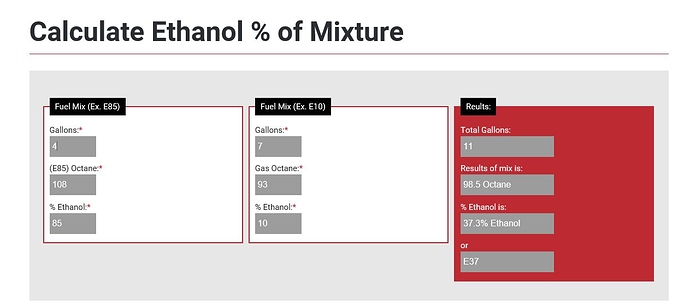I’m just loaded with a bunch of other stuff at the moment but I am looking hard at using E85 in the RS5. I’m going to deposit information here as I find it and maybe others can contribute and I can update the top thread.
First and foremost, understand that each and every car sold in the U.S. after a certain date has to be ethanol compatible. That means the internal components can withstand the corrosive nature of ethanol. This does not mean they can use E85 without any modifications. Far from it.
E85’s actual energy content, per gallon is about 66% less than a comparable amount of gasoline. That means you need 33% more E85 to meet stoich. Stoich on E85 is about 9.8:1 where gas is 14.7:1. What this means is your fuel system needs to flow far more fuel to meet the needs of the engine at wide open throttle.
So while your seals, hoses, and everything else can withstand ethanol, it doesn’t mean it can keep up with the demand for fuel at 8300rpm.
Where’s the weak link? We have the low pressure in-tank pump assembly, the high pressure fuel pumps (HPFP) which sit in the engine bay above the valve covers and the injectors themselves. At this point I don’t know if the injectors or the HPFP can keep up but based on reading from the S4 section, the low pressure in-tank pump is definitely a weak link.
Ok but I don’t own an S4 so how does this apply? Turns out the A4/S4/S5/RS5 in-tank low pressure fuel pump is the same part number, 8K0919051AS. That’s for the OEM RS5 pump.
Audi does make flex-fuel vehicles, the A4 being one of them. Shocker, the in-tank pump unit is exactly the same across various flex-fuel models and will work on a number of non-flex fuel vehicles including the RS5. The flex-fuel in-tank pump is 8K0919051AN.
The “AN” denotes flex fuel.
So what’s the difference between the two pumps? The “AN” flex fuel version flows more volume. Very important.
The HPFP’s and the injectors are still an unknown. The HPFP’s are only shared by the RS5 and the A8 although there’s another HPFP that bolts right in. I can’t remember if they’re from the RS6 V10 or the W12 A8.
The fuel injectors are the same ones used on the R8 V10, S6, S7 and a few other Audis. Unclear if the RS7 injectors will fit, plug in or even flow more.
So where do you start? First, figure out if you even have E85 stations near where you live. I’m fortunate in that I have one within a few miles of my home. Once you’ve located one or two stations which carry E85, you’ll need to get a sample and test it. This is a really simple thing to do. Just go on Amazon and get an E85 test vile which is nothing more than a plastic tube with measuring lines. Fill the vile up with the appropriate amount of water and ethanol based on said lines, shake, and within a minute, you’ll know how much alcohol it contains.
But wait, E85 is supposed to be 85% alcohol, no? E85 has summer and winter blends just like regular gas. Typically, the ethanol content in summer is higher, usually E70 or greater. It gets lower in winter so there’s less benefit in running it during the chilly part of the year.
Why run it at all? Well, if it’s 85% ethanol, a full E85, the octane rating is 108. See where I’m going with this? In addition, the exhaust gas temperatures are lower with ethanol than “gas” as it burns cooler and contains less BTU per unit measurement than pump gas.
Knowing the ethanol content can vary, we’ll need to monitor it on a regular basis and ensure the ethanol content meets the requirements of the ECU tune. Yes, you can take that vial purchased off of Amazon and test it each and every time at the station but that’s a bit tedious. Instead, there are a number of ways to monitor the content in-tank with an ethanol flex-fuel sensor.
There are inexpensive ways to monitor ethanol content and really expensive ways. The more convenient it is, the more expensive it tends to be. I’ll most likely go with something from https://www.fuel-it.com which allows for bluetooth monitoring over your smart phone. You can source many of the parts, like the actual Continental sensor, separately and build up most of the kit for less and add the Bluetooth module.
There are hobbyist-built kits which have small LCD readouts for mounting somewhere in the cockpit. They tend to be much less expensive. Here’s one such kit which is functional with the Fuel-it kit; https://www.n54tech.com/forums/showthread.php?t=32356
If you have a P3 gauge, there’s a way to send the ethanol reading to the gauge; https://www.audizine.com/forum/showthread.php/808038-DIY-Adding-an-Ethanol-Sensor-to-Your-P3-Guage
Once the monitoring system is chosen, we’ll need to splice into the factory lines to install the sensor. More to come as I get to this point…



